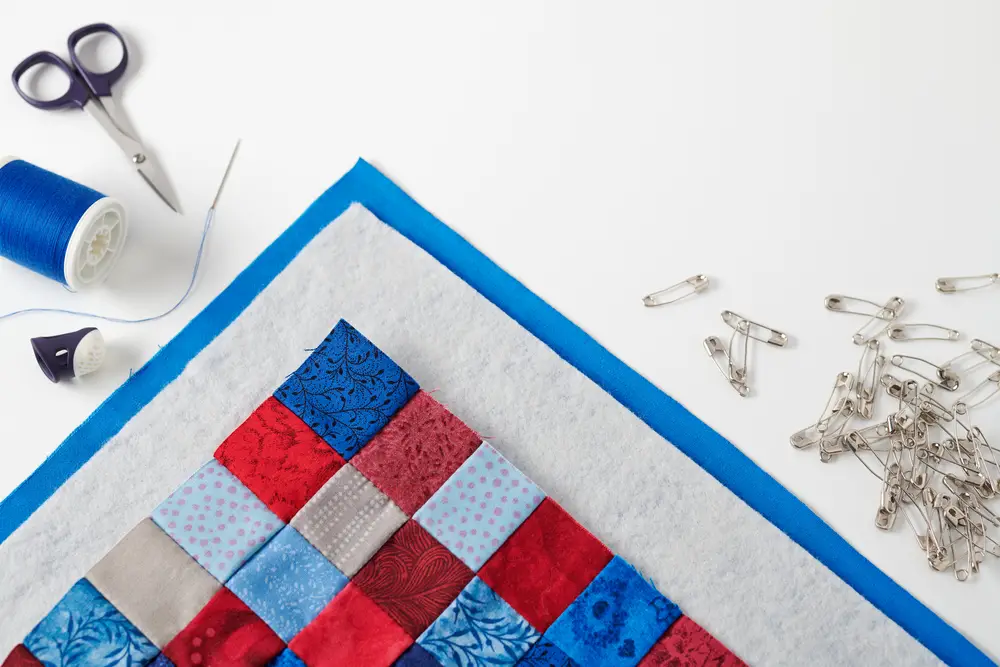Perhaps you’re browsing through a few different potential future projects, only to come across a few terms you’re not unsure of. So, now you find yourself surfing the internet, ticking off each unknown term as you figure out what it means.
Regardless of why you need to know the definition of batting in sewing, we’re here to help, so keep reading to learn more!
What Is Batting?
Batting is a type of filling used for lining quilts and blankets or for stuffing or packaging. It comes in thin sheets or layers of raw cotton, wool, or synthetic fibrous material. Manufacturers have even started to use bamboo fibers to create quilt batting in recent years.
Batting is the material that helps make quilts and blankets heavy, warm, and cozy. As you browse for batting for your sewing project, you’ll notice a few different loft labels. ‘Loft’ refers to the weight and thickness of the batting.
High loft refers to thick, heavy, fluffy layers of batting. Low loft means thin, lightweight layers of batting. So, if you’re creating a thick, heavy quilt or comforter, use a high loft batting. Or, if you’re building a lightweight blanket, use a low loft batting.
Generally, bamboo is the lightest loft of batting, while wool is usually the thickest batting. Batting typically comes in white and off-white, neutral colors, although you might be able to find different options. It really depends on where you go to buy the material.
If you want a loose, drapey blanket, go for bamboo or polyester batting. These materials tend to drape better than the thicker choices. High loft battings, especially wool, tend to be more rigid and hold their shape better. While this is great for a comforter that doesn’t need to be overly malleable, it’s not ideal for a small lap blanket.
What Can I Use Instead Of Batting?
If you can’t find batting in your area or would prefer not to use it at all, there are a few different alternatives. For instance, you could make a stunning summer quilt sans batting – it would be lightweight, which is great for warmer temperatures.
A few alternatives to batting include:

- Fleece sheets or blankets: Fleece blankets and sheets are generally widely available and are the ideal lightweight alternative to batting. The material is pretty affordable and comes in various colors. If you use fleece instead of batting, make sure you wash it before using it, as it shrinks at a higher rate than other materials.
- Cotton sheets: A nice, thin, 100 percent cotton sheet is another option instead of batting. Like fleece, cotton sheets are widely available. The material offers the perfect amount of stabilization between the quilt top and the backing.
- Cotton yardage: This is another excellent option, especially if you have extra cotton fabric lying around. It works just like cotton sheets, offering excellent stability.
- Old quilts or blankets: If you have old, worn-out blankets or quilts, use those for a bit of stabilization and fluff between your quilt layers. It’s a great way to reuse old fabric and reduce waste!
- Pieces of batting: While this technically isn’t a batting alternative, it’s still an option. If you have random bits of extra batting, consider piecing them together to use them in your new sewing craft.
Are Batting And Interfacing The Same?
Nope, batting and interfacing aren’t the same. Batting adds cushion and insulation to your project, whereas interfacing is all about creating stiffness in a particular piece of fabric. When using interfacing, you need to join the two pieces (fabric and interfacing) together.
In some cases, you use an iron to attach the two pieces. The adhesive side heats up under the iron, fusing the fabric and lending stiffness and structure.
Because of the different purposes, batting and interfacing aren’t generally interchangeable. While you could use batting instead of interfacing to lend structure to a bag or something similar, you probably wouldn’t want to use interfacing between quilt layers.
Frequently Asked Questions (FAQs)
Can You Sew Cotton Batting With A Sewing Machine?
Absolutely – you can sew batting with a sewing machine. Whether you’re sewing layers of batting together or attaching them to your fabric, the sewing machine shouldn’t have any issues sewing through the batting.
Of course, certain high loft battings may present an issue, but thinner, lightweight options shouldn’t be an issue. If you’re working on a machine quilting project, you probably don’t want to hand-stitch the entire layer of batting to the fabric. So, set the hand sewing needle aside and use the sewing machine!
Should You Wash Batting Before Sewing?
You don’t necessarily have to wash batting fresh out of the package. For the most part, you can prewash the batting if you want to, but some types may not hold up as well as others. Most modern quilt batting is designed to resist issues like shrinkage, so it only shrinks minimally.
That said – if the batting you’re using is very old, dirty, or from a recycled blanket, you should probably wash it before you use it. Or, if you accidentally spilled something on it or it emanates an unpleasant odor, cleaning it is a good idea.



